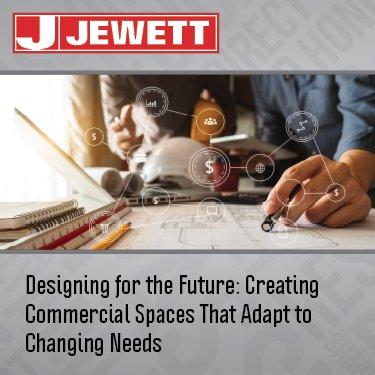Designing for the Future: Creating Commercial Spaces That Adapt to Changing Needs
October 1st, 2024
Designing for the Future: Creating Commercial Spaces That Adapt to Changing Needs | 10/2/24

The pace of change in the commercial real estate world is faster than ever. Businesses are navigating rapid shifts in technology, market dynamics, and employee expectations—all of which impact how commercial spaces are used. In this evolving landscape, the ability to adapt is key, and achieving that adaptability starts with collaboration between owners, and their design teams, and a realistic understanding of the project budget. Future-proof design is becoming a cornerstone of successful commercial projects, allowing spaces to evolve with changing tenant requirements and market trends without straining financial resources. But what exactly does it mean to design for the future, and how can construction professionals create spaces that not only serve current needs but also adapt to meet whatever comes next? In this blog, we’ll explore strategies for designing flexible, adaptable, and resilient commercial spaces that are aligned with owner goals, design priorities, and financial constraints as well as spaces that are agile enough to keep up with changing tenant requirements, evolving market trends and emerging business models.
1. Prioritize Flexibility in Floorplans
One of the most effective ways to create future-proof commercial spaces is by designing with flexibility in mind. Rather than rigid layouts that confine tenants to a single use, flexible floor plans allow for quick reconfigurations and multifunctional spaces. This design approach is especially valuable in office, retail, and mixed-use developments where tenant needs can shift rapidly.
Strategies to Implement:
- Open Layouts: Utilize open layouts that can be easily partitioned or reconfigured without extensive renovations.
- Modular Design: Incorporate modular elements like moveable walls, partition systems, and demountable partitions that allow for quick adjustments.
- Universal Design Principles: Focus on designing spaces that accommodate a variety of uses, from collaborative meeting rooms to quiet workspaces, ensuring that each area can be repurposed as needed.
By prioritizing flexibility, owners and developers can attract a broader range of tenants and provide spaces that grow with their businesses, ultimately reducing vacancy rates and increasing long-term value.
2. Integrate Smart Building Technology
Incorporating smart building technology is no longer a luxury—it’s a necessity for future-ready commercial spaces. Technology solutions that monitor, optimize, and automate building functions make spaces more energy-efficient, adaptable, and user-friendly. They also help tenants modify spaces based on changing needs without major disruptions.
Key Technologies to Consider:
- IoT Sensors: Install Internet of Things (IoT) sensors to track real-time data on occupancy, temperature, lighting, and energy usage, allowing for dynamic space adjustments.
- Smart HVAC Systems: Use smart HVAC systems that adjust heating and cooling based on usage patterns, improving comfort and energy efficiency.
- Advanced Access Control: Implement adaptive access control and security systems that can be easily modified as tenant requirements change.
- Integrated Management Platforms: Use integrated platforms that allow tenants and property managers to control and monitor building systems from a single interface.
Smart technology not only makes commercial spaces more appealing to tech-savvy tenants, but it also improves long-term building performance and flexibility.
3. Embrace Sustainable Design for Longevity
Sustainability isn’t just a trend—it’s a critical component of future-proof design. Sustainable buildings are designed to minimize environmental impact, optimize resource use, and reduce operating costs over time. As environmental regulations and market expectations evolve, sustainable spaces are better positioned to meet new standards and attract eco-conscious tenants.
Sustainability Strategies:
- Adaptive Reuse: When possible, focus on adaptive reuse of existing buildings rather than new construction, preserving historical elements while integrating modern features.
- Energy Efficiency: Invest in high-performance insulation, energy-efficient windows, and renewable energy sources like solar panels to reduce operational costs.
- Sustainable Materials: Use sustainable and recyclable materials, like low-VOC paints, recycled steel, and FSC-certified wood, to create a healthier environment for occupants.
- Green Certifications: Aim for certifications like LEED or WELL to showcase the building’s sustainability credentials, which are increasingly important to tenants and investors.
By designing with sustainability in mind, commercial spaces not only reduce their environmental footprint but also maintain a competitive edge as regulatory and market demands shift.
4. Design for Multiple Uses and User Types
Gone are the days when a commercial building served a single purpose. The rise of mixed-use developments is transforming commercial spaces into hubs that blend retail, office, hospitality, and residential uses. By designing with multiple user types and purposes in mind, developers can create spaces that serve a wider range of needs and adapt to changing demands.
Designing for Multiple Uses:
- Mixed-Use Zoning: Incorporate a mix of commercial, residential, and community spaces within the same development to maximize utility.
- Flexible Amenity Spaces: Create shared amenity spaces that can be used for various purposes, such as coworking areas, meeting rooms, event spaces, or fitness facilities.
- Interchangeable Use Areas: Design certain areas with interchangeable use in mind, such as retail spaces that can be converted into showrooms, pop-up shops, or cafes.
By building in versatility, commercial spaces can cater to diverse tenant requirements and accommodate new business models, such as coworking, co-living, or experiential retail.
5. Plan for Scalability and Growth
In commercial construction, it’s essential to plan for growth—not just for individual tenants but for the entire building or development. Designing for scalability means anticipating future needs and ensuring that expansions or modifications can be made without major disruptions.
Scalability Considerations:
- Future-Ready Infrastructure: Invest in robust infrastructure, like enhanced electrical capacity, reinforced structural elements, and expanded utility systems, to support future upgrades.
- Phased Development Plans: Design in phases, allowing for future additions or modifications without disturbing current operations.
- Shared Utilities and Amenities: Implement shared utilities, such as centralized HVAC or modular utility systems, that can be scaled up or down as demand shifts.
Scalable design allows for a smoother evolution of the space, enabling owners to respond to market changes and tenant growth without starting from scratch.
6. Incorporate Wellness-Centric Design
The post-pandemic era has seen a significant shift toward wellness-focused spaces that prioritize occupant health, comfort, and productivity. From biophilic design to air quality improvements, creating spaces that promote well-being is not only a draw for tenants but also a smart long-term strategy for maintaining occupancy and tenant satisfaction.
Wellness Design Features:
- Biophilic Design Elements: Integrate natural elements like plants, green walls, and water features to enhance occupant well-being and reduce stress.
- Improved Air Quality: Utilize advanced air filtration systems and materials that emit low or zero VOCs to maintain healthy indoor environments.
- Access to Natural Light: Prioritize layouts that maximize natural light exposure, which has been shown to improve mood and productivity.
- Ergonomic and Comfortable Spaces: Incorporate comfortable, ergonomic furniture and layouts that encourage movement and interaction.
By designing for wellness, commercial spaces can better support the evolving expectations of tenants who prioritize health and well-being in their work and community environments.
Looking Ahead: Building Spaces That Evolve
Creating future-proof commercial spaces requires a forward-thinking approach that goes beyond current needs and anticipates tomorrow’s challenges. By incorporating flexibility, smart technology, sustainability, multi-use functionality, scalability, and wellness-focused design, construction professionals can deliver adaptable spaces that continue to meet tenant and market demands—no matter what the future holds.
Whether you’re building a new project or updating an existing one, designing with these strategies in mind will ensure your commercial spaces stay relevant, resilient, and valuable for years to come.
Contact us today to learn more about how we can support your next project and contribute to your business’s success.
For more information, visit us at: jewettconstruction.com

About Jewett: Jewett Construction Company is a full-service commercial construction company, design-builder, general contractor, and commercial construction manager with projects across the East Coast and offices in New Hampshire and Maine.
Jewett Construction through its licensed division Jewett Design LLC. (“Jewett”) provides architectural services.








